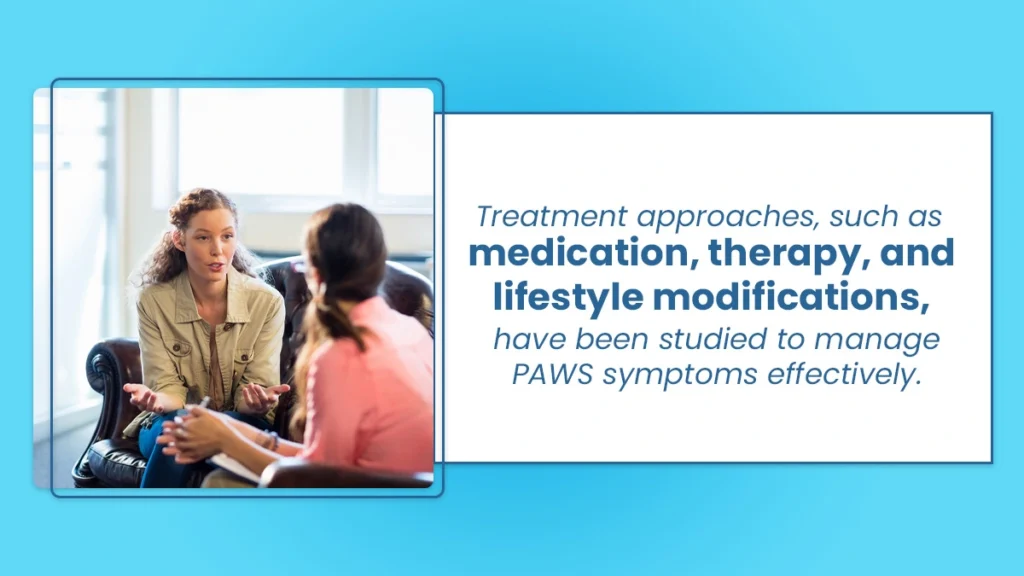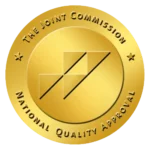Post-acute withdrawal syndrome (PAWS) is a condition that can occur after a person stops using drugs or alcohol. It happens because the body and brain adjust to the substance’s absence.

PAWS can persist for weeks or even months, and it can cause a variety of dangerous symptoms. These symptoms can make it hard for individuals to stay sober and maintain their recovery.
Therefore, it is important for people experiencing PAWS to seek support from healthcare professionals, counselors, and support groups. By understanding and managing PAWS, individuals can increase their chances of long-term sobriety.
Key Takeaways
Post-acute withdrawal syndrome (PAWS) is a set of withdrawal symptoms that can occur after stopping the use of drugs or alcohol.
Here is what this article discusses about PAWS:
- PAWS can be caused by chemical imbalances in the brain, protracted withdrawal, and damage to the CNS due to substance use.
- The duration of PAWS can vary based on factors like the severity of addiction, the type of substance used, and the length of use.
- Treatment options for PAWS include medications, counseling and therapy, and healthy lifestyle changes.
- Ongoing support and monitoring, identifying and addressing triggers, and developing coping skills can help prevent relapse during PAWS.
The Haven Detox-Little Rock provides the necessary support and treatments to help individuals safely navigate through all phases of withdrawal. Contact us today at (501) 271-3342 for more details.
Diving Into the Origins: What Triggers PAWS
Post-acute withdrawal syndrome (PAWS) can feel like a stubborn hurdle for those recovering from drug or alcohol addiction. Understanding the root causes of this condition is key to overcoming it. There are five primary causes of PAWS:
Chemical Imbalance in the Brain
One of the main causes of PAWS is a chemical imbalance in the brain. Substance abuse causes a disturbance in the proper functioning of neurotransmitters, which are responsible for communication between brain cells.
When a person stops using the substance, the brain struggles to readjust to the new chemical balance, leading to various symptoms. This imbalance can contribute to anxiety, depression, mood swings, and other emotional and psychological issues.
Protracted Withdrawal
Another cause of PAWS is protracted withdrawal. This refers to an extended withdrawal period after the initial acute withdrawal phase.
While acute withdrawal typically lasts a few days to a few weeks, protracted withdrawal can persist more. During this time, the body and brain continue to adapt to the absence of the substance, leading to ongoing symptoms such as insomnia, fatigue, and difficulty concentrating.
Damage to the Central Nervous System
Another contributing factor to PAWS is damage to the central nervous system (CNS). Prolonged substance abuse can harm the delicate structures of the CNS, including the brain and spinal cord.
This damage can disrupt normal neurological functions and result in persistent symptoms during recovery. Cognitive difficulties, memory problems, and impaired coordination are common manifestations of central nervous system damage.
Genetics
Genetics can also play a part in PAWS. Some people might be more prone to experience PAWS based on their genetic makeup. This doesn’t mean they’re doomed to struggle with PAWS, but it might mean they must work harder to overcome it.
Type of Substance Abused
Lastly, the type of substance abuse can influence whether they experience PAWS. Some substances, like alcohol and benzodiazepines, are more likely to cause PAWS than others.
The Lingering Effects: Common Symptoms of PAWS
Post-acute withdrawal syndrome (PAWS) involves many different symptoms, which can be emotional, mental, or physical. These symptoms can pop up weeks or even months after someone gets sober.
Let’s dig into these symptoms and how they can affect people.
Emotional Symptoms
Understanding the emotional symptoms of post-acute withdrawal syndrome (PAWS) is crucial to the recovery journey.
Anxiety: This is a common symptom. It can make you feel nervous, worried, or scared. You might have a racing heart or sweaty palms. Remember, it’s not your fault. It’s a sign your brain is adjusting to life without substances.
Depression: You might feel sad or hopeless or lose interest in things you once enjoyed. This can be hard to face, but knowing it’s a normal part of PAWS is important. Reach out to a health professional if you’re feeling this way.
Mood Swings: You could be happy one minute and upset the next. This can lead to feelings of frustration, both for yourself and those around you. Practicing patience with yourself is key.
Irritability: Little things might get on your nerves, and you might lose your temper easily. Just like mood swings, this can strain your relationships. Communicating about your experience can help others understand.
Emotional Oversensitivity: An intensified emotional response to situations, leading to increased sensitivity.
Mental Symptoms
Mental symptoms of PAWS are also common, affecting your cognitive abilities.
Memory Problems: You might forget things easily or need help remembering details. This is because your brain is healing and adjusting.
Difficulties in Concentration: Focusing on tasks or conversations may become challenging. Be patient with yourself and take breaks when needed.
Cognitive Impairments: Besides memory and concentration issues, you might find it hard to learn new things or make decisions. Remember, your brain is relearning how to function without substances.
Disorientation: Feeling confused or disoriented, having difficulty understanding and navigating one’s surroundings.
Obsessive-Compulsive Symptoms: Intrusive thoughts or repetitive behaviors can significantly impact daily functioning.
Physical Symptoms
Physical symptoms are often the most noticeable. They remind us that recovery isn’t just mental but also physical.
Sleep Disturbances: Finding it hard to fall asleep or stay asleep and experiencing vivid dreams can be noted. A regular sleep schedule can help your body adjust.
Gastrointestinal Distress: Symptoms like stomach cramps, indigestion, bloating, or constipation.
Drug Cravings: You might still want the substance even though you’ve stopped using it. This is normal. Reach out to a support person or group when these cravings hit.
Sweating: Excessive sweating, even in cool temperatures or without physical exertion.
Fatigue: Feeling tired all the time could be common. This is your body’s way of telling you it’s healing. Rest when needed, and eat a balanced diet to support your recovery.
Appetite Changes: You might feel hungry all the time, or you might not want to eat at all. Try to maintain a balanced diet; good nutrition can aid in your recovery.
Unveiling the Timeline: How Long Does PAWS Last
The duration of post-acute withdrawal syndrome (PAWS) can vary from one individual to another, depending on various factors, including the substance used, the duration and intensity of substance abuse, and individual factors, such as overall health and genetics.
While the PAWS timeline is not set in stone, understanding the general progression can help individuals and their support systems navigate through this phase of the recovery process.
Acute Withdrawal: The initial withdrawal stage occurs shortly after substance cessation and typically lasts a few days to a few weeks. During this phase, individuals may experience intense physical symptoms such as nausea, sweating, and drug cravings.
Early PAWS: Individuals may enter the early PAWS stage following the acute withdrawal phase. This phase can persist for several weeks to a few months. During this time, symptoms may persist but gradually decrease in intensity. Emotional symptoms like anxiety, depression, mood swings, mild cognitive impairments, and sleep disturbances may still exist.
Protracted PAWS: PAWS can extend beyond a few months into a protracted phase for some individuals. This phase can last from several months to a year or more. While the severity of symptoms tends to lessen during this phase, they can still occur intermittently, and individuals may experience occasional setbacks. Stress, environmental factors, or other challenges may trigger symptoms.
Residual Symptoms: Individuals may sometimes experience residual symptoms beyond one year. These residual symptoms are typically milder and occur infrequently. Certain situations or stressors may trigger them but do not significantly impair daily functioning.
Treatment and Management of PAWS: Restoring Balance
Dealing with post-acute withdrawal syndrome (PAWS) is a journey that requires patience and resilience. Remember, you don’t have to navigate through this challenging situation alone. Here are key steps to take for managing and treating PAWS effectively.
Importance of Professional Support
Seeking help from professionals is an important first step in managing PAWS.
Guidance: Professionals like doctors and therapists can offer the right guidance and resources for managing your symptoms.
Safety: PAWS can be uncomfortable and sometimes dangerous. Professionals ensure your safety during this challenging time.
Personalized Treatment: Everyone experiences PAWS differently. A healthcare provider can design a treatment plan tailored to your unique needs.
Medications
Sometimes, medication may be necessary to manage PAWS. Always take medication under a healthcare provider’s supervision.
Alleviate Symptoms: Certain medications can ease anxiety, depression, and sleep disorders.
Maintenance Medication: Some drugs help maintain sobriety and reduce cravings, like buprenorphine for opioid addiction.
Monitor Side Effects: Healthcare professionals can watch for side effects and adjust dosages accordingly.
Counseling and Therapy
Therapy is an important part of PAWS management. It can help you better equip yourself to cope with symptoms and cravings.
Cognitive Behavioral Therapy (CBT): CBT is a talk therapy that helps individuals understand and change behavior patterns. It is effective for dealing with PAWS because it can teach coping skills, assist in recognizing and avoiding triggers, and provide tools to manage stress and cravings.
Family Therapy: Involving family members in therapy can help them understand what you’re going through and how they can support you.
Group Therapy: Group therapy offers a chance to build connections with individuals who understand and relate to your struggles and experiences, offering a supportive network.
Healthy Lifestyle Changes
Lifestyle changes can help manage PAWS symptoms and improve your overall well-being.
Exercise: Regular physical activity is beneficial in managing PAWS. Exercise helps release endorphins, brain chemicals that act as natural mood lifters. Physical activity is the best stress reliever and can help manage PAWS symptoms.
Nutrition: Proper nutrition is key to supporting your body as it recovers. Opting for a diet rich in fruits, veggies, lean proteins, and whole grains can provide the nutrients your body needs. Drinking plenty of water can help manage symptoms like fatigue and cravings.
Stress Management Techniques: Managing stress is crucial when dealing with PAWS. Mindfulness and meditation can assist you to relax and focus, reducing stress and anxiety. Simple breathing exercises can help calm your mind and body. Engaging in enjoyable activities can distract from cravings and reduce stress.
Staying on the Path: Measures To Prevent PAWS Relapse
Recovering from addiction is a journey, and part of that journey includes dealing with post-acute withdrawal syndrome (PAWS). But what happens when you’re faced with the possibility of a relapse? Here are some strategies to prevent a PAWS relapse:
Ongoing Support and Monitoring
One of the best ways to avoid a relapse is to have ongoing support and monitoring:
Continued Professional Support: Even after the worst symptoms of PAWS subside, it’s vital to seek help from addiction professionals. They can keep a record of your progress and provide the necessary support.
Regular Check-ups: Frequent visits to your healthcare provider can help you stay on track. They can spot signs of a potential relapse early and help prevent it.
Support Groups: Joining a support group, whether online or in person, can also be beneficial. Engaging with people who have had similar experiences can provide comfort and advice.
Identifying and Addressing Triggers
Recognizing what triggers your cravings can help prevent a relapse:
Self-awareness: Pay attention to which situations or emotions make you want to use substances again. This could be stress, certain people, or specific places.
Action Plan: Identify your triggers and develop a plan for how to cope with them. This could involve avoiding certain situations, finding new effective ways to manage stressful situations, or talking to someone when you’re feeling vulnerable.
Developing Coping Skills
Learning how to deal with difficult feelings or situations without turning to substances is key to preventing a relapse:
Problem-Solving: Practice coming up with solutions for problems without using substances. It can boost your confidence and empower you to navigate challenges effectively.
Stress Management: Techniques like meditation, yoga, or deep breathing, can be powerful tools for managing stress.
Healthy Habits: Eating a balanced diet, getting enough sleep, and exercising regularly can help you feel better overall and better manage PAWS.
Frequently Asked Questions (FAQs)
What are the different post-acute withdrawal symptoms someone could have?
Post-acute withdrawal syndrome (PAWS) can include a variety of symptoms:
Feeling anxious or worried
Feeling down or depressed
Mood swings, where feelings change quickly
Getting upset or frustrated easily
Problems with memory, like forgetting things
Trouble focusing or paying attention
Difficulty thinking clearly or making decisions
The trouble with sleeping or feeling tired even after sleep
Strong cravings to use the substance again
Feeling tired all the time, even without much physical activity
Changes in eating habits, either eating more or less than usual
How long does withdrawal syndrome last?
Withdrawal syndrome duration varies depending on the substance used:
Alcohol: Withdrawal can last up to two weeks.
Benzodiazepines: Withdrawal may last a few weeks to several months.
Opioids: Withdrawal typically lasts a week or more.
Cocaine: Withdrawal can last for several weeks.
Nicotine: Withdrawal often lasts a few weeks.
This is the acute withdrawal phase. Post-acute withdrawal syndrome (PAWS) can follow and last several months or even years but usually becomes less intense.
How long does post-acute withdrawal syndrome (PAWS) last?
The duration of post-acute withdrawal syndrome (PAWS) can vary widely:
Short Term: PAWS might last only a few weeks or months for some people. They may experience symptoms like mood swings, sleep disturbances, or difficulty focusing.
Medium Term: For others, PAWS could last up to a year. They might still have mood swings, trouble sleeping, and memory problems.
Long Term: In some cases, PAWS can persist for several years. The symptoms might become less severe over time but could still be present.
Remember, everyone’s experience with PAWS is different, and the timeline can depend on many factors, like the type of substance and the length of use.
What drugs can cure post-acute withdrawal syndrome?
While there isn’t a specific drug to “cure” post-acute withdrawal syndrome (PAWS), certain medications may help manage its symptoms:
Antidepressants: Medications like SSRIs can help with depression and mood swings.
Anti-Anxiety Medications: Drugs like buspirone can be used to manage anxiety disorders.
Sleep Aids: Certain medications can help with insomnia or disrupted sleep patterns.
Remember, all medications should be taken under the supervision of a healthcare provider.
Embrace a Sober Life at The Haven Detox-Little Rock
Don’t let substance use disorder (SUD) control your life any longer. Take the first step toward recovery today at The Haven Detox-Little Rock. We’re here to guide you safely through the withdrawal storm, be it the initial or the post-acute phase.
Our medical detox program ensures your safety and comfort as your body adjusts to being substance-free. Our residential and outpatient treatments and evidence-based therapies are designed to build a strong foundation for a substance-free life. We’ve covered you with our dual diagnosis treatment if you’re also dealing with mental health issues.
Take control today. Make the brave choice to start your recovery journey with us at The Haven Detox-Little Rock. Let us help you reclaim your life from substance use. Don’t wait. Your healthier future is just a call away. Contact us at (501) 271-3342 to learn more about our programs and service charges.



